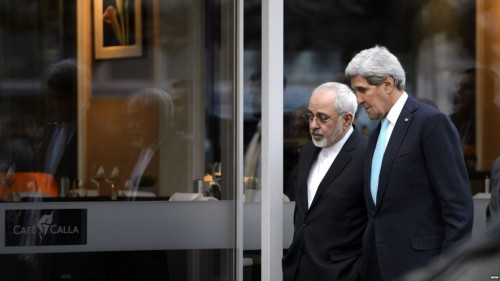Iran’s Foreign Minister Mohammad Javad Zarif and US Secretary of State John Kerry in Geneva, Switzerland, January 2015
On the eve of his nuclear talks with Iran’s Foreign Minister Mohammad Javad Zarif, US Secretary of State John Kerry has warned that “significant gaps” remain in the pursuit of a comprehensive agreement by a July 1 deadline.
In London en route to Geneva, Kerry said, “There are still significant gaps, there is still a distance to travel.”
He warned, “President Obama has no inclination whatsoever to extend these talks beyond the period that has been set out”, and said that Obama was “fully prepared to stop these talks” if necessary.
Iran and the US renewed talks on Friday, with Deputy Foreign Minister Abbas Araqchi and Undersecretary of State Wendy Sherman heading the delegations. Political negotiations were accompanied by technical discussions, with the head of Iran’s Atomic Energy Organization, Ali Akbar Salehi, joining on Saturday.
However, the effort for agreement has been overshadowed by a dispute between the US and Iran over the process. The Americans are now setting out a two-stage resolution, with an agreement on General Principles by March 31 and a full deal by July 1.
The Iranians, following the line set by the Supreme Leader, insist that the settlement must be a a full and final one-stage arrangement, including the lifting of US and European sanctions on Iran’s oil and banking sectors within six months.
Zarif repeated on Saturday, “No other deal will be reached before a complete agreement is clinched.”
In another sign of the difficulty of reaching a settlement, unnamed “Western diplomats and senior Israeli officials” leaked details of a proposal by the 5+1 Powers (US, Britain, France, Germany, China, and Russia) made two weeks ago in Munich — the clauses of which are distant from Iran’s stated “red lines”.
1. Iran will be able to continue operating its 6,000–6,500 old-generation [IR-1] centrifuges to enrich uranium to a low level of 3.5–5 percent. It will not be able to operate new-generation centrifuges, and the existing centrifuges will be modified to reduce their enrichment capability.
(Iran has indicated that it wants to expand enrichment capacity beyond that of the currently-operating stock of just under 10,000 IR-1 centrifuges. That includes putting into operation some of the IR-2 centrifuges which it installed, but did not put into operation, from early 2013.)
2. Iran will have to remove most of its enriched uranium to Russia, where it will be turned into non-weapons-grade nuclear fuel. Iran will be able to keep 300 kilograms of low-enriched uranium, less than that required to produce a nuclear weapon.
(Presumably “low-enriched” means 5% uranium, with all 20% uranium shipped out of Iran. The Islamic Republic has indicated that it will only accept such a proposal with firm guarantees of the return of fuel plates to Tehran, and it has not shown a willingness to reduce its 5% stock to such a low level.)
3. The heavy water reactor at Arak will be modified to reduce the amount of plutonium it can produce.
(*This is probably acceptable to the Iranians.)
4. The agreement will remain in place for 15 years, during which time Tehran will remain under the strict supervision of the International Atomic Energy Commission.
(*Iran has indicated that it wants a much shorter agreement, although it may be flexible if there is a guarantee that sanctions will be lifted and not-reimposed)
5. Sanctions will be lifted only gradually, in keeping with Iran’s fulfillment of its obligations.
(*This condition is unacceptable to the Iranians, who want relief in the near-future for oil exports and key sectors of the economy.)
The European Union’s foreign policy chief Federica Mogherini will join Kerry and Zarif on Sunday. Talks may then follow between Iran and the 5+1 Powers.

